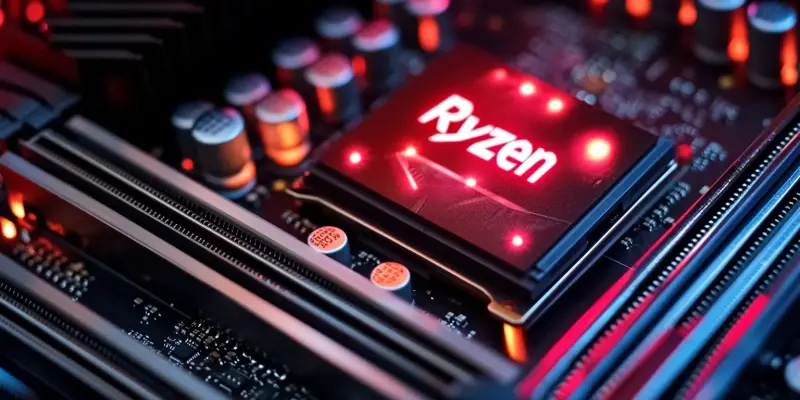With the recent announcement from AMD at CES 2025, tech enthusiasts are buzzing about the impressive capabilities of the new Ryzen AI Max+ 395 “Strix Halo” APU. This chip is designed for high-end enthusiasts and workstation-grade laptops and integrates both a powerful Zen 5 CPU architecture and an RDNA 3.5-based Radeon 8060S GPU. The gaming benchmarks presented by AMD reveal that the Ryzen AI Max+ 395 can significantly outperform the NVIDIA GeForce RTX 4070 laptop GPU, setting a new standard in integrated GPU performance. The Ryzen AI Max+ 395’s potential to challenge traditional high-end discrete GPUs presents an intriguing shift in the paradigm of laptop gaming performance.
Breaking Down the Ryzen AI Max+ 395 APU
Architecture and Design
The Ryzen AI Max+ 395 “Strix Halo” showcases AMD’s commitment to innovation by utilizing a multi-die configuration that incorporates CPU and GPU performance elements on a single APU. Central to this design is the use of CCDs (Core Complex Dies) for CPU operations and an IOD (Input/Output Die) that houses the graphics unit, all interconnected via AMD’s next-generation Infinity Fabric. This provides a cohesive integration aimed at maximizing performance efficiency and throughput. Plus, the new memory interface supports bandwidths reaching up to 256 GB/s, an improvement that ensures seamless data processing and delivery.
Additionally, the flagship model boasts 16 cores and 32 threads, with base clock speeds starting at 3.0 GHz and boosting up to an impressive 5.1 GHz. It also comes with 80 MB of cache and has a variable TDP ranging from 45W to 120W. Such specifications not only make it highly competitive but also flexible for various user needs, from casual gaming to intensive workstation tasks. The inclusion of a 50 TOPS “XDNA 2” NPU (Neural Processing Unit) further enhances the APU’s AI capabilities, an increasingly vital feature in current and future computing environments.
Integrated Radeon 8060S GPU
A critical component of the Ryzen AI Max+ 395 is its integrated Radeon 8060S GPU, designed with 40 Compute Units clocked up to 2900 MHz. The combination of these high-performance components allows for substantial improvements in gaming benchmarks when compared to the NVIDIA GeForce RTX 4070. Gamers can expect an average performance uplift of 23.2% across 17 popular game titles tested at 1080p high settings. Specific games show even greater enhancements, such as Hitman 3 experiencing a 50.4% boost, Middle Earth: Shadow of War seeing a 29.2% increase, and Borderlands 3 rocketing ahead by 68.1%.
These statistics indicate that AMD’s engineering efforts in optimizing integrated GPU performance are paying off significantly. The seamless blend of CPU and GPU functionality within a single APU footprint not only enhances overall performance but also offers significant energy efficiency advantages. This could potentially position the Ryzen AI Max+ 395 as an ideal choice for gamers and content creators who need powerful yet portable solutions without the premium pricing associated with high-end discrete GPUs.
AMD’s Strategic Vision with Strix Halo
Setting New Standards in Mobility Platforms
AMD’s introduction of the Strix Halo series represents a bold step towards redefining performance expectations for mobile computing platforms. By integrating high-end CPU and GPU capabilities in a single APU, AMD is challenging the status quo dominated by discrete GPU solutions. This strategy positions AMD not merely as a competitor but as an industry leader driving innovation and change in laptop design and performance. The benchmarks reveal the Ryzen AI Max+ 395 outperforms several discrete GPUs, making it a viable alternative for those looking for powerful, efficient, and compact devices.
Moreover, the innovative Infinity Fabric interconnect and memory interface highlight the engineering prowess AMD has invested in these APUs. The move indicates a broader trend towards more integrated solutions capable of delivering top-tier performance without the bulk and power demands of traditional high-end laptops. Enthusiasts and professionals alike will likely appreciate the increased portability and efficiency of these laptops, which do not compromise on the performance needed for demanding applications.
Future Implications and Advancements
While the current success of the Ryzen AI Max+ 395 and the Strix Halo series is notable, AMD’s roadmap suggests even more significant advancements on the horizon. The current generation is based on the RDNA 3.5 architecture, but the future is poised for RDNA 4-based APUs, which could push performance boundaries even further. AMD’s continuous investment in AI capabilities, as seen in the inclusion of the XDNA 2 NPU, indicates a foresight into the evolving demands of both gaming and professional workloads that increasingly rely on AI-driven processes and acceleration.
The potential for these integrated APUs goes beyond just gaming. As machine learning and AI become foundational in various industries, a powerful integrated GPU combined with a high-performing CPU will be crucial in delivering efficient, responsive solutions. The Strix Halo series, therefore, represents not just a leap in gaming technology but a forward-thinking approach to computing as a whole, underlining AMD’s commitment to driving future-proof innovations in the computing landscape.
Conclusion
With AMD’s recent announcement at CES 2025, tech enthusiasts are excited about the new Ryzen AI Max+ 395 “Strix Halo” APU. This advanced chip is geared towards high-end enthusiasts and workstation-grade laptops, boasting both a powerful Zen 5 CPU architecture and an RDNA 3.5-based Radeon 8060S GPU. According to gaming benchmarks shared by AMD, the Ryzen AI Max+ 395 outperforms the NVIDIA GeForce RTX 4070 laptop GPU, setting a new benchmark in integrated GPU performance. This development suggests a groundbreaking shift in laptop gaming performance, as the Ryzen AI Max+ 395 has the potential to rival traditional high-end discrete GPUs. The integration of such powerful components in a single APU may revolutionize the expectations for gaming laptops, offering a blend of performance and efficiency that was previously unattainable. This technological advancement represents a significant milestone, potentially reshaping the future landscape of mobile computing and gaming, and signaling an exciting era for PC enthusiasts and gamers alike.

